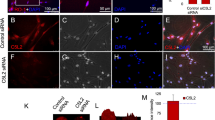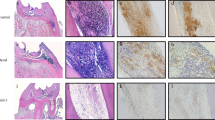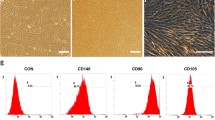ABSTRACT
The aim of this study was to examine the anti-inflammatory effect of brain-derived neurotrophic factor (BDNF) on human dental pulp cells (HDPCs) and identify the intracellular signaling pathway involved. We investigated the effect of BDNF (50 ng/ml) on interleukin (IL)-6 and IL-8 expression in peptidoglycan (PGN)-treated HDPCs. An inhibition assay was performed with MAPK or NF-κB inhibitors to determine the possible signaling pathway. IL-6 and IL-8 mRNA, IL-6 and IL-8 protein, and phosphorylated p38 kinase activity were determined using real-time PCR, ELISA, and Western blot analysis, respectively. BDNF significantly attenuated PGN-induced IL-6 and IL-8 mRNA and protein levels in HDPCs. A p38 inhibitor also inhibited IL-6 and IL-8 mRNA transcription. PGN stimulated phosphorylated p38 kinase activity in HDPCs, which was inhibited by BDNF. Suppression of phosphorylated p38 kinase activity by BDNF in HDPCs inhibited increased IL-6 and IL-8 expression induced by PGN. Our findings suggest that BDNF regulates intracellular signaling molecule activities to exert its anti-inflammatory effect.




Similar content being viewed by others
REFERENCES
Dammaschke, T., J. Leidinger, and E. Schafer. 2010. Long-term evaluation of direct pulp capping—treatment outcomes over an average period of 6.1 years. Clinical Oral Investigations 14: 559–67.
Ghoddusi, J., M. Forghani, and I. Parisay. 2014. New approaches in vital pulp therapy in permanent teeth. Iranian Endodontic J 9: 15–22.
Goldberg, M., J.C. Farges, S. Lacerda-Pinheiro, N. Six, N. Jegat, F. Decup, et al. 2008. Inflammatory and immunological aspects of dental pulp repair. Pharmacological Research 58: 137–47.
Ko, Y.J., K.Y. Kwon, K.Y. Kum, W.C. Lee, S.H. Baek, M.K. Kang, et al. 2015. The anti-inflammatory effect of human telomerase-derived peptide on P. gingivalis lipopolysaccharide-induced inflammatory cytokine production and its mechanism in human dental pulp cells. Mediators Inflammation 2015: 385127.
Matsushima, K., E. Ohbayashi, H. Takeuchi, S. Hosoya, Y. Abiko, and M. Yamazaki. 1998. Stimulation of interleukin-6 production in human dental pulp cells by peptidoglycans from Lactobacillus casei. Journal of Endodontics 24: 252–5.
Nakanishi, T., K. Mukai, H. Yumoto, K. Hirao, Y. Hosokawa, and T. Matsuo. 2010. Anti-inflammatory effect of catechin on cultured human dental pulp cells affected by bacteria-derived factors. European Journal of Oral Sciences 118: 145–50.
Coil, J., E. Tam, and J.D. Waterfield. 2004. Proinflammatory cytokine profiles in pulp fibroblasts stimulated with lipopolysaccharide and methyl mercaptan. Journal of Endodontics 30: 88–91.
Zehnder, M., N. Delaleu, Y. Du, and M. Bickel. 2003. Cytokine gene expression—part of host defence in pulpitis. Cytokine 22: 84–8.
Barbacid, M. 1994. The Trk family of neurotrophin receptors. Journal of Neurobiology 25: 1386–403.
Ebendal, T. 1992. Function and evolution in the NGF family and its receptors. Journal of Neuroscience Research 32: 461–70.
Johnson, D., A. Lanahan, C.R. Buck, A. Sehgal, C. Morgan, E. Mercer, et al. 1986. Expression and structure of the human NGF receptor. Cell 47: 545–54.
Radeke, M.J., T.P. Misko, C. Hsu, L.A. Herzenberg, and E.M. Shooter. 1987. Gene transfer and molecular cloning of the rat nerve growth factor receptor. Nature 325: 593–7.
Patapoutian, A., and L.F. Reichardt. 2001. Trk receptors: mediators of neurotrophin action. Current Opinion in Neurobiology 11: 272–80.
Kajiya, M., H. Shiba, T. Fujita, K. Ouhara, K. Takeda, N. Mizuno, et al. 2008. Brain-derived neurotrophic factor stimulates bone/cementum-related protein gene expression in cementoblasts. Journal of Biological Chemistry 283: 16259–67.
Kajiya, M., H. Shiba, T. Fujita, K. Takeda, Y. Uchida, H. Kawaguchi, et al. 2009. Brain-derived neurotrophic factor protects cementoblasts from serum starvation-induced cell death. Journal of Cellular Physiology 221: 696–706.
Kerschensteiner, M., E. Gallmeier, L. Behrens, V.V. Leal, T. Misgeld, W.E. Klinkert, et al. 1999. Activated human T cells, B cells, and monocytes produce brain-derived neurotrophic factor in vitro and in inflammatory brain lesions: a neuroprotective role of inflammation? Journal of Experimental Medicine 189: 865–70.
Nakahashi, T., H. Fujimura, C.A. Altar, J. Li, J. Kambayashi, N.N. Tandon, et al. 2000. Vascular endothelial cells synthesize and secrete brain-derived neurotrophic factor. FEBS Letters 470: 113–7.
Nakanishi, T., K. Takahashi, C. Aoki, K. Nishikawa, T. Hattori, and S. Taniguchi. 1994. Expression of nerve growth factor family neurotrophins in a mouse osteoblastic cell line. Biochemical and Biophysical Research Communications 198: 891–7.
Takeda, K., H. Shiba, N. Mizuno, N. Hasegawa, Y. Mouri, A. Hirachi, et al. 2005. Brain-derived neurotrophic factor enhances periodontal tissue regeneration. Tissue Engineering 11: 1618–29.
Takeda, K., N. Sakai, H. Shiba, T. Nagahara, T. Fujita, M. Kajiya, et al. 2011. Characteristics of high-molecular-weight hyaluronic acid as a brain-derived neurotrophic factor scaffold in periodontal tissue regeneration. Tissue Engineering Part A 17: 955–67.
Mizuno, N., H. Shiba, W.P. Xu, T. Inui, T. Fujita, M. Kajiya, et al. 2007. Effect of neurotrophins on differentiation, calcification and proliferation in cultures of human pulp cells. Cell Biology International 31: 1462–9.
Juarez-Verdayes, M.A., S. Rodriguez-Martinez, M.E. Cancino-Diaz, and J.C. Cancino-Diaz. 2013. Peptidoglycan and muramyl dipeptide from Staphylococcus aureus induce the expression of VEGF-A in human limbal fibroblasts with the participation of TLR2-NFkappaB and NOD2-EGFR. Graefes Archive for Clinical and Experimental Ophthalmology 251: 53–62.
Ji, X.C., Y.Y. Dang, H.Y. Gao, Z.T. Wang, M. Gao, Y. Yang, et al. 2015. Local Injection of Lenti-BDNF at the Lesion Site Promotes M2 Macrophage Polarization and Inhibits Inflammatory Response After Spinal Cord Injury in Mice. Cellular and Molecular Neurobiology 35: 881–90.
Takeda, K., P. Kermani, A. Anastasia, Y. Obinata, B.L. Hempstead, and H. Kurihara. 2013. BDNF protects human vascular endothelial cells from TNFalpha-induced apoptosis. Biochemical Cell Biology 91: 341–9.
Groneberg, D.A., T.C. Fischer, N. Peckenschneider, O. Noga, Q.T. Dinh, T. Welte, et al. 2007. Cell type-specific regulation of brain-derived neurotrophic factor in states of allergic inflammation. Clinical and Experimental Allergy 37: 1386–91.
Noga, O., C. Englmann, G. Hanf, A. Grutzkau, S. Guhl, and G. Kunkel. 2002. Activation of the specific neurotrophin receptors TrkA, TrkB and TrkC influences the function of eosinophils. Clinical and Experimental Allergy 32: 1348–54.
Rezaee, F., S.L. Rellick, G. Piedimonte, S.M. Akers, H.A. O’Leary, K. Martin, et al. 2010. Neurotrophins regulate bone marrow stromal cell IL∂6 expression through the MAPK pathway. PLoS One 5, e9690.
Chen, B.C., C.C. Liao, M.J. Hsu, Y.T. Liao, C.C. Lin, J.R. Sheu, et al. 2006. Peptidoglycan-induced IL-6 production in RAW 264.7 macrophages is mediated by cyclooxygenase-2, PGE2/PGE4 receptors, protein kinase A, I kappa B kinase, and NF-kappa B. Journal of Immunology 177: 681–93.
Kumar, A., J. Zhang, and F.S. Yu. 2004. Innate immune response of corneal epithelial cells to Staphylococcus aureus infection: role of peptidoglycan in stimulating proinflammatory cytokine secretion. Investigative Ophthalmology & Visual Science 45: 3513–22.
Hirao, K., H. Yumoto, T. Nakanishi, K. Mukai, K. Takahashi, D. Takegawa, et al. 2010. Tea catechins reduce inflammatory reactions via mitogen-activated protein kinase pathways in toll-like receptor 2 ligand-stimulated dental pulp cells. Life Sciences 86: 654–60.
Matsuda, S., T. Fujita, M. Kajiya, K. Takeda, H. Shiba, H. Kawaguchi, et al. 2012. Brain-derived neurotrophic factor induces migration of endothelial cells through a TrkB-ERK-integrin alphaVbeta3-FAK cascade. Journal of Cellular Physiology 227: 2123–9.
ACKNOWLEDGMENTS
This work was supported in part by JSPS KAKENHI Grant Number JP25463218.
Author information
Authors and Affiliations
Corresponding author
Rights and permissions
About this article
Cite this article
Takeda, K., Tokunaga, N., Aida, Y. et al. Brain-Derived Neurotrophic Factor Inhibits Peptidoglycan-Induced Inflammatory Cytokine Expression in Human Dental Pulp Cells. Inflammation 40, 240–247 (2017). https://doi.org/10.1007/s10753-016-0474-4
Published:
Issue Date:
DOI: https://doi.org/10.1007/s10753-016-0474-4




